ExchangeTraded Funds (ETFs) have gained immense popularity among investors due to their diversified exposure, liquidity, and relatively low costs compared to traditional mutual funds. However, like any investment vehicle, ETFs also have certain limitations and regulations governing their price movements. Let's delve into whether ETFs have restrictions on price increases and explore the factors influencing their price dynamics.
ETFs are designed to track the performance of a specific index, commodity, bond, or a basket of assets. Their prices are determined by the underlying assets they hold. Unlike individual stocks, ETFs trade on exchanges throughout the day at marketdetermined prices, which may deviate from the net asset value (NAV) of the fund.
ETFs do not have explicit restrictions on price increases. Instead, their prices are subject to the forces of supply and demand, market sentiment, and the performance of the underlying assets. However, several factors can influence the extent of price increases in ETFs:
1.
2.
3.

4.
While there are no specific restrictions on ETF price increases, regulatory bodies like the Securities and Exchange Commission (SEC) impose safeguards to protect investors from potential risks associated with ETF trading:
1.
2.
While ETFs offer several benefits, including diversification, flexibility, and transparency, investors should consider the following guidelines to navigate potential limitations on price increases:
1.
2.
3.
4.
While ETFs do not have explicit restrictions on price increases, their prices are influenced by various factors, including market efficiency, arbitrage mechanisms, liquidity, and underlying asset performance. Regulatory safeguards ensure transparency and investor protection, mitigating potential risks associated with ETF trading. By understanding these dynamics and adhering to prudent investment practices, investors can navigate ETF markets effectively and capitalize on their wealthbuilding potential.
This HTML document provides comprehensive insights into the limitations on ETF price increases, regulatory safeguards, and actionable guidance for investors to optimize their ETF investments. Whether you're a novice investor or a seasoned professional, understanding these principles is essential for building a robust investment portfolio.

在2024年的澳门,每一次的开奖结果都不仅仅是数字的简单排列,它们背...

在信息爆炸的时代,获取准确、全面的资料对于任何领域的研究者来说都是至...

在信息爆炸的时代,获取高质量的学习资源对于学生和教育工作者来说至关重...

在博弈世界中,”澳门一肖一码100%准确1”...

随着2024年的到来,香港特马的开奖结果成为了众多彩民关注的焦点。本...